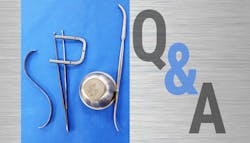Disinfecting dropped instruments, Cleaning verification - essential for cannulated medical devices
Submit your questions: email: [email protected]
Q
We have reached the point of a good, old-fashioned standoff amongst members of our CSSD team when it comes to the issue of an instrument being dropped on the floor in the assembly process and what should be done with it. We have a 50/50 split between sending the instrument back to the decontamination area to be cleaned or wiping it off with a disinfecting wipe. Can you help shed some light on this matter?
A
The best practice would be to return the instrument to the decontamination area for complete cleaning and reprocessing. Aside from contamination, an instrument dropped on the floor also could be damaged, and therefore should be carefully inspected for damage and proper functioning. You would not want to wipe the instrument off with a disinfectant wipe for the
following reasons:
- The chemical disinfectant may not be compatible with the instrument material or finish and could damage the instrument.
- Cleaning is ALWAYS a prerequisite to disinfecting, so the instrument needs to be thoroughly cleaned with a detergent prior to disinfecting.
- To be effective, disinfectants must remain moist on all surfaces of the item being disinfected for a prescribe period of time according to the manufacturer’s instructions for use (IFU), thus the use of disinfectant wipes is not necessarily a faster process.
- Following exposure to a chemical disinfectant, the chemical agent must be rinsed from the instrument.
- If the instrument is urgently needed, you can clean it manually according to the manufacturer’s IFU.
- The wipe-off game is a RISKY GAME. Be sure to read the instructions very carefully and follow them precisely.
Q
I am the sterile processing quality assurance coordinator for a large healthcare system, which includes a clinical research center. The research center utilizes many unique medical devices, including many prototypes, which require reprocessing and sterilization. A new instrument set that includes several small canulated devices and specialty needles was recently introduced at the research center. I am concerned about cleaning these items effectively; they are visibly inspected and appear to be clean, and when the channels are flushed the water appears to be clear. However, I am concerned about the possibility of invisible soils that may remain in the channels, presenting a barrier to effective sterilization and posing a risk to patient infection. Can you suggest any additional methods that I could incorporate into our processes to ensure that the items are thoroughly clean and free of any organic soils?
A
As you noted, effective cleaning must include the removal of visible as well as invisible soil. Channeled and cannulated medical devices are amongst the most challenging to clean; residual soils remaining in the lumen of these devices can inhibit the sterilization process and indeed result in the transmission of infectious agents from one patient to another. With the widely publicized reports in the media of breaches in cleaning procedures, which have placed thousands of patients at risk, coupled with professional standards and recommendations, cleaning verification has become the standard of practice.
About the Author

Ray Taurasi
Ray Taurasi is Principal, Healthcare CS Solutions. His healthcare career spans over five decades as an Administrator, Educator, Technologist and Consultant. He is a member of AORN, SGNA, AAMI and a past president of IAHCSMM. Taurasi has been a faculty member of numerous colleges teaching in the divisions of business administration, nursing, and health sciences. He is the author of numerous articles and textbook chapters; he is a frequent speaker at national and international healthcare conferences.
Note to readers from Ray Taurasi - In 2021, my life’s career path will transition to one of new opportunities and adventures. As a result, after nearly 19 years and 225 CS Solution columns, this edition will be my last.
“All changes, even the most longed for, have their melancholy; for what we leave behind us is a part of ourselves; we must die to one life before we can enter another.”– Anatole France
I wish you and your loved ones a healthy and joyful holiday season and a beautiful New Year! God Speed, Ray
https://www.facebook.com/pages/category/ Local-Business/Healthcare-CS-Solutions-128857 3061153887/ • email: [email protected]

